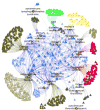The Genetics of Multiple Sclerosis: From 0 to 200 in 50 Years
- PMID: 28987266
- PMCID: PMC5701819
- DOI: 10.1016/j.tig.2017.09.004
The Genetics of Multiple Sclerosis: From 0 to 200 in 50 Years
Abstract
Multiple sclerosis (MS) is a common autoimmune disease that targets myelin in the central nervous system (CNS). Multiple genome-wide association studies (GWAS) over the past 10 years have uncovered more than 200 loci that independently contribute to disease pathogenesis. As with many other complex diseases, risk of developing MS is driven by multiple common variants whose biological effects are not immediately clear. Here, we present a historical perspective on the progress made in MS genetics and discuss current work geared towards creating a more complete model that accurately represents the genetic landscape of MS susceptibility. Such a model necessarily includes a better understanding of the individual contributions of each common variant to the cellular phenotypes, and interactions with other genes and with the environment. Future genetic studies in MS will likely focus on the role of rare variants and endophenotypes.
Keywords: GWAS; gene regulatory networks; genetic pathways; multiple sclerosis.
Copyright © 2017 Elsevier Ltd. All rights reserved.
Figures



References
-
- Hauser SL, Goodin DS. Multiple Sclerosis and other demyelinating diseases. In: Longo DI, editor. Harrison’s principles of internal medicine. 19. McGraw-Hill: 2015. pp. 3395–3409.
-
- Compston A, Coles A. Multiple sclerosis. Lancet. 2008;372(9648):1502–17. - PubMed
-
- Hedstrom AK, et al. Environmental factors and their interactions with risk genotypes in MS susceptibility. Curr Opin Neurol. 2016;29(3):293–8. - PubMed
-
- Hedstrom AK, et al. Smoking is a major preventable risk factor for multiple sclerosis. Mult Scler. 2016;22(8):1021–6. - PubMed
-
- Olsson T, et al. Interactions between genetic, lifestyle and environmental risk factors for multiple sclerosis. Nat Rev Neurol. 2017;13(1):25–36. - PubMed
Publication types
MeSH terms
Grants and funding
LinkOut - more resources
Full Text Sources
Other Literature Sources
Medical
Research Materials
Miscellaneous

